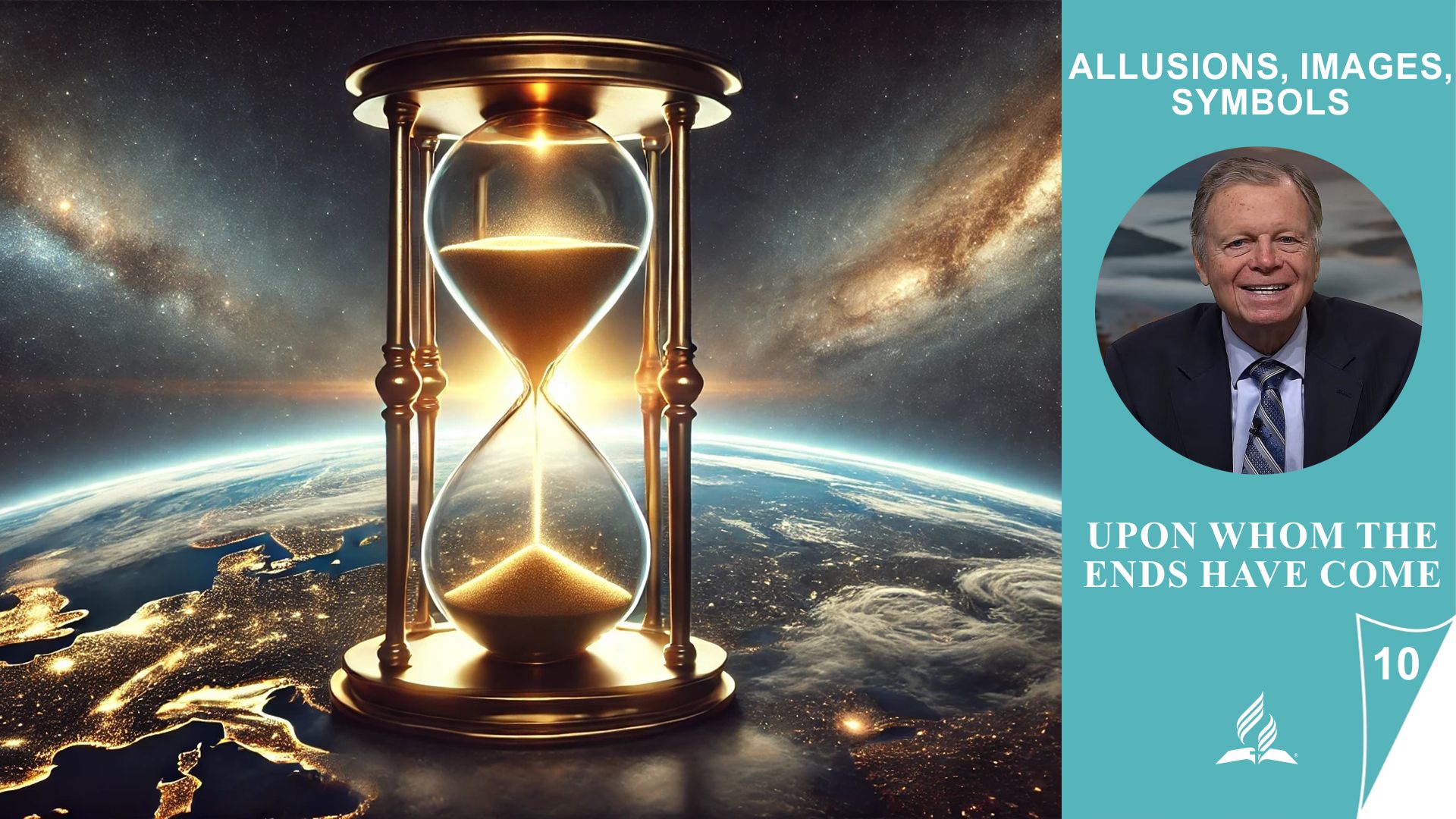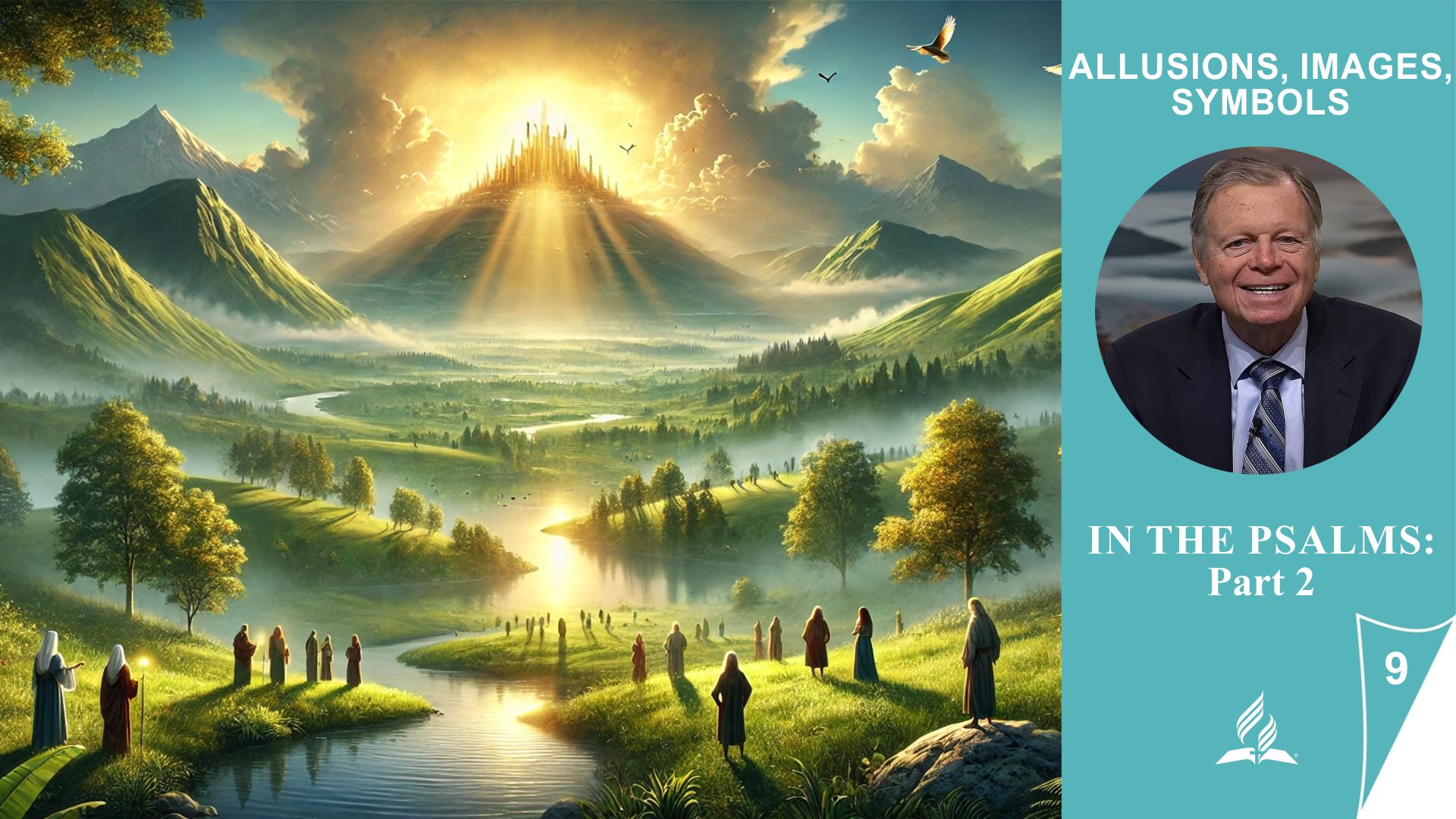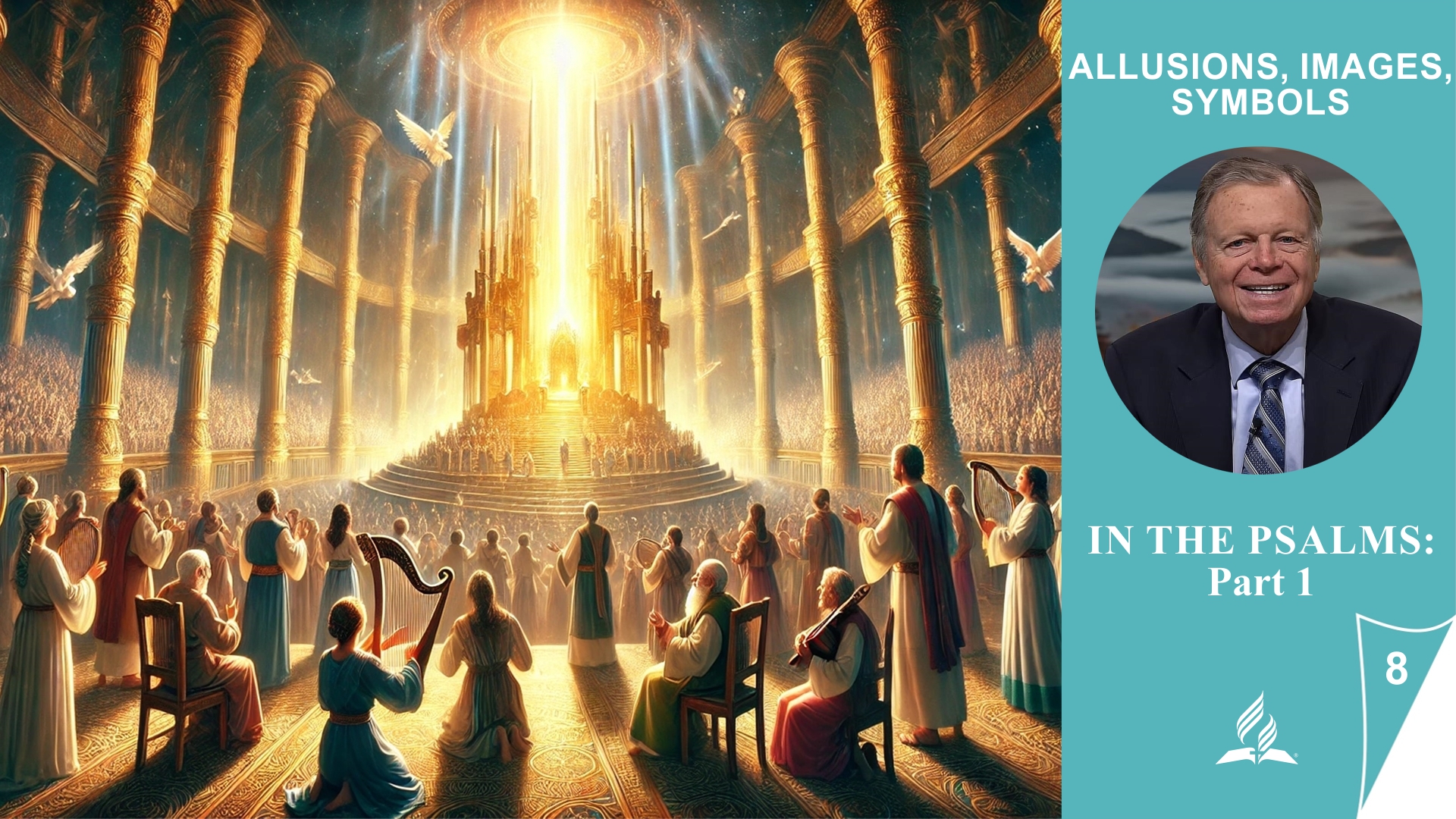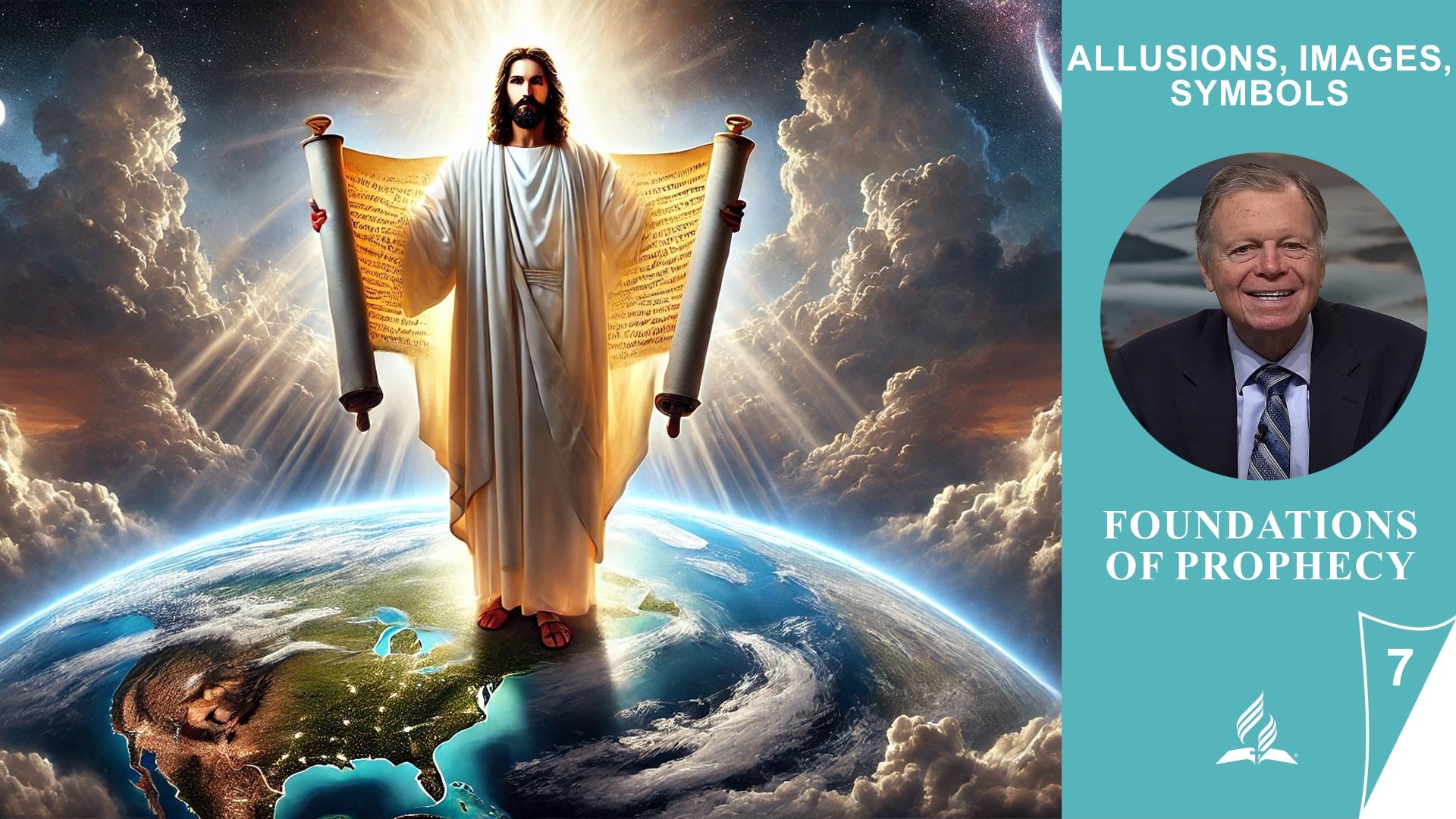
Allusions, Images, Symbols – Lesson 9.In the Psalms: Part 2 | Sabbath School with Pastor Mark Finley

Series ALLUSIONS, IMAGES, SYMBOLS with Pastor Mark Finley |
Lesson 9. In the Psalms: Part 2 |
Divine Promises and End-Time Perspectives in the Psalms |
In Lesson 9 we dive into the rich world of the Psalms and discover how these ancient songs of praise reflect the central themes of end-time prophecy. We begin with Psalm 46, which assures us of God’s unshakeable help amid chaos, and follow its call to faithfulness and rest in the face of judgmental upheaval. Psalm 47 and Zechariah 14 show us that as Christians we will not only be saved but will reign as co-regents in Christ’s kingdom. With Psalm 75 we learn of God’s justice that topples proud powers, while the blood of the new covenant in Matthew 26 and Revelation 14 brings the decisive turning point. Finally, Psalm 67 exhorts us not to keep God’s light to ourselves but to let it shine out to all nations. This lesson invites us to anchor our hope in God’s sovereign power and to take an active part in His end-time mission.
Content:
9.1 A Very Present Help in the Time of Trouble
God Our Rock and Refuge – Confidence in Crisis and the End Times
Psalm 46 presents us with an unshakeable Helper who is our refuge amid earthquakes, warfare, and global chaos. Even if “the earth gives way and the mountains fall into the heart of the sea” (Ps 46:3), we need not fear, for God Himself is our security. This promise applies not only to personal crises but also points to end-time visions in which heaven and earth are shaken (Rev 6:14; 2 Pet 3:12). In Christ on the cross—the true basis of our hope—we see the perfect revelation of God’s goodness, power, and faithfulness. When we “be still, and know that I am God” (Ps 46:11), we anchor our trust not in temporary turmoil but in the unshakeable promise of a new, eternal peace. Thus this psalm encourages us to stand firm and cling daily to Jesus’s victory over sin and death.
9.2 Hope Amid Turmoil
The Unmoved Throne over a Storm-Tossed World
Psalm 46 and Jeremiah 4 vividly depict a world in total collapse—physically and politically—to prepare the stage for God’s final renewal. Daniel 7 shows how successive, unstable kingdoms rise from the “turbulent sea” of nations, yet none can quell the chaos or solve humanity’s deepest problems. Our true citizenship lies in the kingdom of God, which sits high above all earthly upheaval (Phil 3:20; Ezek 1:26). Christ’s return will mark the moment when these broken powers finally fall, making way for a new heaven and a new earth (Rev 22:1). Until then, we remain steadfast in faith—not clutching foolishly at this world, but confident that God’s promises stand firm (Ps 46:7–8). This prophetic perspective fills us with hope: the last word belongs not to chaos, but to the King whose throne endures forever.
9.3 Under His Feet
Reigning with Christ over the Earth
Psalm 47:2–5 promises that God will make His people inherit the nations and place them under our feet—a picture of our reign in Christ’s kingdom. In 1 Thessalonians 4:13–17, we encounter Christ in the air as He raptures His bride for the heavenly wedding, while Zechariah 14:4 describes His feet standing on the Mount of Olives at the close of the millennial reign. These two passages reveal two interconnected aspects of Christ’s ultimate rule: our union with the exalted Lord in the rapture and our shared reign with Him at the end of the age. Satan once claimed dominion over the earth, but Christ—and with Him His saints—will ultimately hold rightful authority over all kingdoms. The vision of the New Jerusalem’s descent (VSL 607–608) gives us a living hope: we are not mere pilgrims, but future co-regents at Christ’s throne. Without these promises, life in the face of death would be empty and meaningless—but in Jesus we have a living pledge of eternal fellowship and reign.
9.4 Wine and Blood
From the Cup of Judgment to the Cup of the Covenant
Psalm 75 portrays God as the righteous Judge who shatters the “horns” of proud rulers and repays corrupt dominion with the cup of justice (Ps 75:8). In contrast, Matthew 26:26–29 presents the cup of wine as the symbol of the new covenant in Christ’s blood, uniting us with Him in righteousness. Revelation 14:9–12 warns that those who serve the beast must drink the “wine of God’s wrath,” while the saints, through faith and obedience, escape it and look forward to the eternal kingdom. Thus the narrative spans from the proclamation of judgment on self-exalting powers to Christ’s redeeming self-sacrifice. Until God completes His cosmic renewal, the destruction of the present order remains necessary to eradicate entrenched injustice forever. In this knowledge we live with hope—not in a world that judges itself, but in the promise of the cup that brings us eternal life.
9.5 That Your Salvation May Be Known
Radiant Ambassadors of Salvation in a Dark World
Psalm 67 calls us to receive God’s shining face and to make His ways known among all nations. In Revelation 14:6–12 the “three angels’ messages” continue this mission: proclaiming the eternal gospel, warning against false systems, and calling all to worship the Creator. If we coat our hearts with an ultrablack “nanocoating,” we absorb God’s light without reflecting it, failing to carry His salvation to the world. Instead of hiding in a “VIP lounge” of privilege, Christ has entrusted us with the whole earth as our mission field. Our task as church and individuals is not merely to bask silently in God’s glory, but actively to spread His light across the world and invite all to gather on God’s holy mountain.
9.6 Summary
Hope, Reign, and Mission in God’s Grand Design
In Lesson 9, “In the Psalms, Part 2,” key themes of biblical prophecy unfold: Psalm 46 assures us of God’s presence and victory even in the greatest chaos and final judgment. Psalm 47 and Zechariah 14 reveal that in Christ’s kingdom we will not only be saved but will reign as co-regents over the earth. Psalm 75 speaks of God’s righteous judgment on proud powers and contrasts the cup of wrath with the cup of the new covenant in Christ’s blood. Psalm 67 admonishes us not to keep God’s light to ourselves but to radiate His salvation to all peoples. Together, these passages summon us to active hope—grounded in God’s power and goodness—and to carry His promises forward until the new creation dawns.
Allusions, Images, Symbols – Lesson 8.In the Psalms: Part 1 | Sabbath School with Pastor Mark Finley

Series ALLUSIONS, IMAGES, SYMBOLS with Pastor Mark Finley |
Lesson 8.In the Psalms: Part 1 |
The Psalms and the Sanctuary – Praise, Judgment, and Grace in Harmony |
The Psalms are not merely poetic prayers but deeply rooted experiences of faith cast in the light of the sanctuary. They reflect how God’s people sought, encountered, and celebrated the Lord’s presence in the temple. In connection with the message of Revelation, they show that worship, purity, judgment, and redemption have always been central themes for God’s people. The Psalms answer the question: Who may stand before God—and why? Only through the Lamb’s sacrifice is true fellowship with God possible. This lesson leads us deeper into the sanctuary-based plan of salvation and opens our hearts to what genuine worship means.
Memory Text: Revelation 14:1 – “Then I looked, and behold, a Lamb standing on Mount Zion, and with Him one hundred and forty-four thousand, having His Father’s name written on their foreheads.”
Contents:
8.1 Our High Priest
The Heavenly High Priest – Jesus at the Center of Sanctuary and Hope
The tabernacle was not a human invention but a divine pattern given to Moses exactly as he saw in heaven. This earthly sanctuary was a prophetic replica of the true heavenly sanctuary, where Christ now ministers as our High Priest. Hebrews 9:11–15 shows that Jesus entered the sanctuary once for all—not with animal blood, but with his own—bringing eternal redemption. Revelation picks up this sanctuary language again and makes clear: anyone who would understand God’s plan must recognize Jesus as the center of temple service. Psalm 122 reveals how deeply God’s people were bound to the sanctuary—a place of joy, peace, worship, and divine order. Today we find all that not at a physical location, but in living relationship with Christ, our High Priest.
8.2 On Mount Zion
Who May Dwell on Your Holy Hill? – Only Through the Lamb
In Revelation 14 we see the redeemed standing on Mount Zion—a picture of nearness to God and his presence. Psalms 15 and 24 describe with vivid clarity how holy and pure one must be to dwell on that mountain. These requirements also expose our inability to stand before God by our own strength. That is precisely where the gospel comes in: only the Lamb—Jesus Christ—makes it possible to stand on Mount Zion. His righteousness is credited to us by faith so that we may enter boldly. The Father’s name on our foreheads (Rev. 14:1) expresses a new identity shaped by the Lamb’s blood, not by our own merit.
8.3 Law in Our Hearts
The Name on Our Foreheads – God’s Law Written Within
God’s name represents his character—full of grace, truth, and justice. When Moses asked to see God’s glory, God revealed his name, his very being. Likewise, the name of God on the foreheads of the redeemed in Revelation 14 pictures God’s character written into their minds and hearts. They love him because he first loved them, and that love is expressed in a life aligned with his commandments. The law is no longer a burden but the fruit of an inwardly transformed relationship—an outgrowth of grace, not its precondition. For those who truly know God love his law (1 John 5:3)—not by compulsion but from devotion.
8.4 Psalm 5
Between Judgment and Grace – Psalm 5 and the Message of the Redeemed
Psalm 5 starkly contrasts the godless with the righteous—a theme revisited in Revelation 14. Both texts emphasize that only the redeemed can stand in God’s presence, not by their own works but by the Lamb’s grace. David and John alike link redemption with true worship: encountering God in awe and loving his name. Truthfulness and purity in speech mark God’s end-time people—they reflect God’s character in a world full of deception. The perspective of righteous judgment shows our desperate need for Christ’s righteousness to stand before God. Yet that righteousness is freely given—so we rejoice and proclaim his love with boldness.
8.5 Teach Transgressors Your Way
Forgiven, Cleansed—and Sent
Psalm 51 shows that genuine repentance leads not only to forgiveness but to the desire to guide others in God’s ways. David vows that, once cleansed, he will “teach transgressors your ways”—not from moral self-righteousness but from personal experience of God’s mercy. Just as Isaiah in his throne-room vision, each of us who has received forgiveness is made a messenger. The “eternal gospel” of Revelation 14 is thus the starting point for every other message—it is the foundation for truth, worship, and warning. Only those who themselves have been redeemed can credibly speak of the Redeemer. The world doesn’t need perfect people but authentic witnesses who live by grace.
8.6 Summary
In the Light of the Sanctuary – The Psalms as Guides to God’s Presence
Lesson 8 shows how intimately the Psalms are woven into the sanctuary message and the plan of salvation. They reveal a deep longing for God’s presence, for peace, justice, and true worship. In Psalms 122, 5, 15, and 24 we see that only through the Lamb of God can one access God’s holy mountain. The redeemed in Revelation 14 are not perfect but forgiven—hearts and minds transformed by God’s grace. Their steadfastness, their worship, and their life-witness flow from the “eternal gospel.” The Psalms help us to understand this path—personally, experientially, and with hope.
Allusions, Images, Symbols – Lesson 7.Foundations of Prophecy | Sabbath School with Pastor Mark Finley

Series ALLUSIONS, IMAGES, SYMBOLS with Pastor Mark Finley |
Lesson 7.Foundations of Prophecy |
The Glory of God and the Call to Proclaim – A Glimpse Behind the Veil of Eternity |
Lesson 7 takes us deep into the heart of biblical prophecy—not merely as foretelling the future, but as an encounter with the living God. When God reveals Himself, it is not primarily to convey information, but to transform hearts. The prophets of Scripture were themselves first transformed before being sent—like Isaiah, who, in the light of God’s holiness, became painfully aware of his own sinfulness. The cherubim, symbols of divine nearness and majesty, remind us that true prophecy is born out of God’s presence. In a world crowded with competing voices, this lesson invites us once more to listen to the voice that issues from the throne. For only those who have beheld God’s glory can speak of Him with credibility.
Memory Text: Isajah 6:8 – “Also I heard the voice of the Lord, saying: ‘Whom shall I send, and who will go for Us?’ Then I said, ‘Here am I! Send me’ ”
Content:
7.1 “Here I Am—Send Me!”
Cleansed, Called, Sent—Isaiah’s Response to God’s Grace
Isaiah’s call did not begin with his willingness, but with an honest encounter with God’s holiness. Confronted by divine glory, he saw his own unworthiness—a realization that humbles every human heart. Yet God did not leave him in the dust of his sin: a burning coal touched his lips, cleansing him and equipping him for service. This forgiveness changed everything—from a reluctant bystander into a volunteer. His famous words, “Here am I; send me!” show that true calling is only possible once the heart has been purified. Likewise, through Christ’s grace we too can boldly say “Yes” to God’s call in the world.
7.2 The Two Cherubim
The Cherubim at Eden’s Gate—Guardians of Life, Signs of Hope
The two cherubim stationed at the entrance to the Garden of Eden were not only guardians but also a prophetic symbol of hope. Placed at the eastern gate and suffused with divine glory, they recall God’s presence above the mercy seat, flanked by cherubim in the tabernacle. Although they barred access to the Tree of Life, they also held out a promise: the way back to God was not lost forever. Even in the expulsion lay the promise of redemption—made visible by the light between the cherubim. These heavenly beings announce not only judgment but also grace, pointing forward to Christ, who by His sacrifice would reopen the path to paradise.
7.3 Like Burning Coals of Fire
Fire, Wings, and Glory—A Vision of God’s Throne
The cherubim—mysterious creatures of light and motion—are always depicted in Scripture as close to God’s throne. In Ezekiel’s vision they burn like coals of fire, revealing God’s overwhelming majesty even in the midst of Babylonian exile. Despite the darkness of their situation, this scene reminds us that God’s rule remains supreme—even amid chaos. Parallels in Isaiah and John show that God’s holiness is unchanging, His presence both awe-inspiring and comforting. When we stand before this holiness, we recognize our own fragility—and our desperate need for grace. The cherubim remind us that God is both just and merciful, and that His glory does not abandon His people, even in exile.
7.4 God Among His People
God at the Center—from the Wilderness to Eternity
The layout of Israel’s camp around the tabernacle was no accident, but a divine message: God intended to dwell in the very center of His people. Each tribe had its place surrounding the sanctuary—ordered, connected, and meaningful. Rabbinic tradition assigns each tribe a symbolic image (lion, man, ox, eagle), echoing the four living creatures of Ezekiel and Revelation—as if heaven itself were foreshadowed in the wilderness. This pattern extends to the New Jerusalem, where God again dwells at the center and His people gather around Him. Today, God still calls us to place Him at the center of our lives. Intimacy with Him is not created by geographical arrangement but by devotion, worship, and genuine community.
7.5 The Fall of Lucifer
From Throne to Fall—Lucifer’s Pride and Christ’s Victory
Lucifer’s fall is among the greatest tragedies of creation. Once a covering cherub in God’s immediate presence, he fell into rebellion through pride and self-exaltation. Ezekiel and Isaiah portray this descent as a shift from light to darkness, from praise to accusation. In stark contrast, Revelation 14 shows the redeemed, saved by the Lamb’s blood, standing on Mount Zion—where Lucifer once stood. God’s grace is so vast that fallen humanity is not only forgiven but also appointed heirs—filling the gap left by the fallen angels. This grace compels us: our task is to carry this gospel to all nations with clarity, humility, and passion.
7.6 Summary
When Heaven Touches Earth—God’s Voice in Prophecy
Lesson 7 has explored the prophetic foundations that testify to God’s nearness, holiness, and love. From Isaiah’s call we see that true prophecy always springs from an encounter with God’s glory and the experience of forgiveness. The cherubim—guardians of the sanctuary and symbols of divine presence—thread through all biblical prophecy, pointing to God’s desire to dwell among His people. From Eden to Revelation, we learn: God reveals Himself to save, not to destroy. Lucifer’s fall warns us where pride leads, while the redeemed are called back to the throne by the Lamb. Prophecy is not an end in itself but God’s invitation to hear His voice—and to follow.
Allusions, Images, Symbols – Lesson 5.The Nations: Part 2 | Sabbath School with Pastor Mark Finley
 Series: ALLUSIONS, IMAGES, SYMBOLS
Series: ALLUSIONS, IMAGES, SYMBOLS
 With Pastor Mark Finley
With Pastor Mark Finley
Lesson 5:  The Nations, Part 2
The Nations, Part 2
 God’s Sovereignty over the Kingdoms of the Earth
God’s Sovereignty over the Kingdoms of the Earth
 Introduction
Introduction
The history of the world is not a chaotic game of powers – it is the stage on which God’s eternal plan unfolds. In this lesson, we see how human kingdoms fade away, while God’s kingdom stands on an everlasting foundation. From the fall of Babylon to the emergence of God’s final people, prophecy shows us that God’s will prevails despite turmoil and upheavals. Trusting in His Word, we discover hope beyond all uncertainties.
 Memory Text:
Memory Text:
“Be still, and know that I am God; I will be exalted among the nations, I will be exalted in the earth!”
— Psalm 46:10
 Content:
Content:
 5.1 The Very First Commandment
5.1 The Very First Commandment
 Humanity’s First Test of Obedience
Humanity’s First Test of Obedience
In the Garden of Eden, God not only granted freedom but also set a clear boundary – out of love. The command not to eat from the Tree of Knowledge was meant to protect, not restrict. Even today, we face decisions about whom we listen to in the “garden” of our lives.
 5.2 Daniel 2
5.2 Daniel 2
 From Gold to Ashes—God’s Kingdom Endures
From Gold to Ashes—God’s Kingdom Endures
The statue made of gold, silver, bronze, and iron reveals the decline of human kingdoms. Despite all human achievements, the world remains filled with conflict. Yet at the end stands the “stone cut without hands” — a symbol of God’s eternal kingdom — replacing all earthly powers.
 5.3 Daniel 7
5.3 Daniel 7
 Tumultuous Seas and the Unshakable Kingdom of God
Tumultuous Seas and the Unshakable Kingdom of God
Monstrous beasts rise from stormy waters — a vivid image of human violence and chaos. In the midst of it all, God calls us to hope in His eternal, just kingdom rather than earthly rulers.
 5.4 Between Land and Sea
5.4 Between Land and Sea
 Land of Hope, Sea of Turmoil
Land of Hope, Sea of Turmoil
Land symbolizes divine stability, while the sea represents human unrest. In Revelation 12–13, we see God’s people finding refuge — yet prophecy warns: even apparent havens can change. Only those who trust in God remain truly secure.
 5.5 Prophesy Again
5.5 Prophesy Again
 The Final Message to a Dying World
The Final Message to a Dying World
The remnant church receives the call to “prophesy again,” warning the world and preparing it for Christ’s soon-coming kingdom. Both land and sea will bear witness that God’s light pierces the darkness.
 5.6 Summary
5.6 Summary
 God’s Plan Amid the Kingdoms of This World
God’s Plan Amid the Kingdoms of This World
From Eden to the end times, prophecy shows us: human kingdoms falter, but God’s plan stands firm. Rather than relying on earthly securities, God calls us to be bold, faithful witnesses of His coming kingdom — full of courage and hope.
- « Previous Page
- 1
- …
- 3
- 4
- 5
- 6
- 7
- …
- 384
- Next Page »
